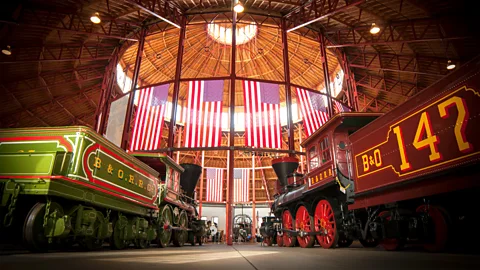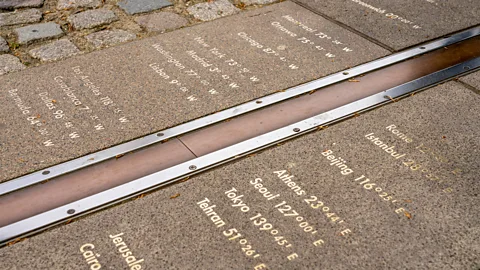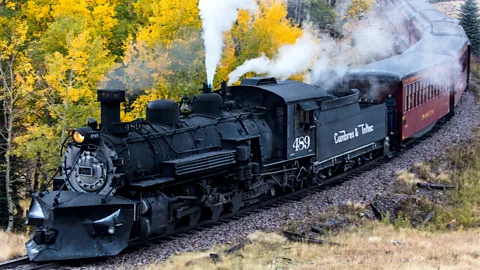The invention of railroads ushered in a new era of land travel and forever changed the way humans perceive time.
On this day in 1883, railroad companies in the United States and Canada transformed time in both countries, leading to the ground-breaking concept of time zones around the world.
For millennia prior to this date, many people around the world measured time-based on the placement of the Sun, with midday (or "high noon") determined by when the Sun was highest in the sky over that particular village or town.
Mechanical clocks eventually started replacing sundials in the Middle Ages. Towns would set their clocks by gauging the position of the Sun, leading every city to operate at a slightly different time. This method lasted well into the 1800s when there were at least 144 different time zones in North America.
Since many people didn't travel especially long distances from their homes throughout history (generally as far as a horse, camel or wagon could carry them on land) this rudimentary form of timekeeping didn't cause much of a problem – that is, until the advent of the railroad.
According to Jon Goldman, chief curator at the B&O Railroad Museum in Baltimore, Maryland, in the mid-1800s, as trains became increasingly popular in the US and Canada and railroads began carrying more passengers and freight across the continent, the need to create a more coordinated timekeeping system wasn't just an issue of efficiency but national safety.

"The existence of different local time zones created major problems for the railroad," he explained. "At best, people might miss their train; at worst, trains were more likely to collide when using a single track."
During this time, the UK – which birthed the modern railway in 1825 – had already experienced a very similar issue. As railroads began to better connect cities and towns to one another, it became apparent that stations couldn't keep listing dozens of arrival and departure times for each train based on local time zones. By 1847, all British railway companies had adopted a single standard "Railway Time" time across their networks. The new timekeeping method (now known as Greenwich Mean Time) was adopted nationwide in 1880, making the UK the first country to standardise time.

Greenwich Mean Time is effectively, the average or "mean" time when the Sun crosses the Prime Meridian at the Royal Observatory Greenwich. Today, travellers can still visit the so-called "Centre of Time" at the observatory in London and straddle the imaginary Prime Meridian line where the eastern and western hemispheres meet.
Standardising time across Great Britain improved efficiency, reduced the number of rail accidents and helped passengers make their connections. As a result, it didn't take long before this idea spread to North America. But unlike the UK which only had to standardise time across a country, the US and Canada needed to figure out a way to standardise time across an entire continent.
In 1879, a Canadian rail engineer named Sir Sandford Fleming came up with a revolutionary idea after missing a train: the creation of time zones. On 18 November 1883, the US and Canadian railroad industries adopted Fleming's idea, but because of the sheer size of the North American continent, it was decided that four major time zones would be created: Eastern, Central, Mountain and Pacific time – each of which remains relatively unchanged to this day.

"With a new unified time zone system, railroad accidents were far less likely to occur," Goldman explained. A year later, Fleming helped convene the International Prime Meridian Conference in Washington DC, where the Greenwich Meridian was selected to be the common zero of longitude and the standard of reckoning time throughout the world.
In North America, local towns and cities, eager for the prosperity and opportunities brought by the railroad, were quick to adopt their continent's new time zones. The US federal government, however, was a bit slower and fully adopted these new time zones in 1918.
Time is just one of many cultural transformations ushered in by the advent of rail travel. As railroads helped to spread people and ideas across the globe, there became a growing need to communicate across vast distances as well. It's no coincidence that the very first electronic message, a telegraph, was sent from the US Capitol Building to Mount Clare rail station in Baltimore, which is now the site of the B&O Railroad Museum. Today at the museum, visitors can see dozens of restored trains, learn more about train travel as part of the Underground Railroad and even ride the Mile One Express, which travels along the first mile of commercial railroad track ever laid in the US. And as the UK counts down the minutes, hours and days until 2025, when nationwide events are scheduled as part of the 200th anniversary of the birth of the modern railroad, there's never been a better time to ponder how the coordinated scheduling of the entire planet started on this day.
Latest Stories
-
Asempa FM’s Ekosiisen supports renal patients with GHS100K, urges gov’t to absorb full cost of dialysis care
12 minutes -
WAFCON 2024: We have ‘good options in attack’ – Bjorkegren backs Queens to improve goalscoring
12 minutes -
Vice President convenes strategic stakeholder meeting on Women’s Development Bank
20 minutes -
Bawumia visits Hawa Koomson after violent attack during Ablekuma North rerun
22 minutes -
Bawumia visits assault victims in Ablekuma North rerun; pledges support
25 minutes -
Mahama charges Transport Minister and Attorney-General to resolve unauthorised shipping charges
28 minutes -
Mahama engages freight forwarders on 24-Hour Economy
29 minutes -
Ghana Armed Forces promotes young soldier who rejected galamsey bribe
2 hours -
NFFA elects Michael Kwetey Tetteh as its president
2 hours -
NPP outlines guidelines ahead of 2025 National Delegates Conference
2 hours -
Ken Ofori-Atta’s extradition: FBI clears first major hurdle – No witch-hunt
2 hours -
NDC executives deny involvement in rogue anti-galamsey taskforce
4 hours -
Bailiff jailed four years for forging judge’s signature
4 hours -
“Oil funds for ‘Big Push’ will be efficiently used,” Mahama assures
4 hours -
Presidency launches gov’t accountability series to enhance transparency
5 hours

